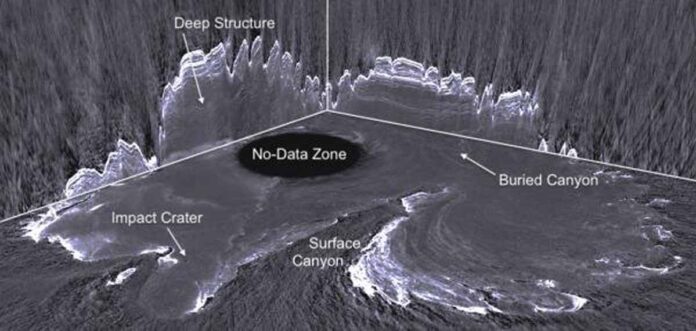Mars’ south pole has received a lot of attention recently due to the mystery of hidden lakes. But don’t overlook the planet’s scenic north pole, an icy wonderland with its secrets. A new 3D radar image of the pole reveals what lies beneath its surface.
A team of researchers led by Nathaniel Putzig of the Planetary Science Institute created a new polar map using radar data collected by NASA’s Mars Reconnaissance Orbiter. The image is known as a radargram. It reveals previously hidden features such as an impact crater and a buried canyon.
MRO has a Shallow Radar (Sharad) instrument that bounces radar waves off Mars, allowing scientists to “see” beneath the surface. The PSI team used that data to create a 3D view of the subsurface. The black oval labeled “no-data zone” is an area that Sharad did not photograph. On Monday, the researchers published their findings in The Planetary Science Journal.
Sharad was built to detect liquid or frozen water. But the reflected radar waves also reveal what’s going on with rocks and sand. It is assisting scientists in developing a picture of how geologic layers were deposited and eroded at the pole.
The radargram may conjure up Lovecraftian visions of a canyon hidden in an icy zone. But it isn’t about sci-fi horror stories. This is about comprehending polar geology and how it relates to the climate history of Mars. Mars, like Earth, is a rocky planet. But it evolved in a very different way to become the hostile environment that it is today.
The 3D map is only the start of the story. “We have only scratched the surface of understanding what the new data volume is telling us about the history of Martian polar processes and climate,” Putzig said. “And there is a lot more detailed mapping work to be done,” Putzig added.
Researchers plan to identify more buried impact craters and assess subsurface structures visible in the image next. The same method used to create the polar radargram could also be used to show what’s going on in other parts of the world. Mars’ beauty and intrigue extend beyond the surface. Below are hints about its past.

